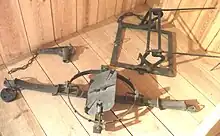
A mantrap is a mechanical physical security device for catching poachers and trespassers.[1] They have taken many forms, the most usual being like a large foothold trap, the steel springs being armed with teeth which meet in the victim's leg. In 1827 they were made illegal in England, except in houses between sunset and sunrise as a defence against burglars.[2][3]
Other traps such as special snares, trap netting, trapping pits, fluidizing solid matter traps[4] and cage traps could be used.
Mantraps that use deadly force are illegal in the United States, and in notable tort law cases the trespasser has successfully sued the property owner for damages caused by the mantrap. There is also the possibility that such traps could endanger emergency service personnel such as firefighters who must forcefully enter such buildings during emergencies. As noted in the important American court case of Katko v. Briney, "the law has always placed a higher value upon human safety than upon mere rights of property".[5]
See also
References
- ↑ "Episode 197: Mantrap (9.23.2022)". This is Criminal. September 23, 2022. Retrieved September 27, 2022.
- ↑ One or more of the preceding sentences incorporates text from a publication now in the public domain: Chisholm, Hugh, ed. (1911). "Man-Traps". Encyclopædia Britannica. Vol. 17 (11th ed.). Cambridge University Press. p. 607.
- ↑ B2 Non Fatal Offences Against the Person. Oxford University Press. 2016.
{{cite book}}:|work=ignored (help) - ↑ "Fluidized sand mantrap". Discovery Channel.
- ↑ Katko v. Briney, 183 N.W.2d 657 (Iowa 1971).
External links
 Media related to Mantraps at Wikimedia Commons
Media related to Mantraps at Wikimedia Commons
